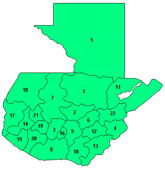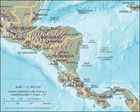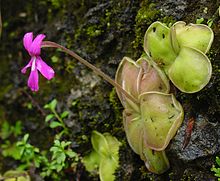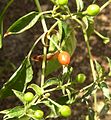The Guatemala portal
Republic of Guatemala República de Guatemala (Spanish) | |
|---|---|
Motto:
| |
| Anthem: Himno Nacional de Guatemala (English: "National Anthem of Guatemala") | |
| ISO 3166 code | GT |
Guatemala, officially the Republic of Guatemala, is a country in Central America. It is bordered to the north and west by Mexico, to the northeast by Belize, to the east by Honduras, and to the southeast by El Salvador. It is hydrologically bordered to the south by the Pacific Ocean and to the northeast by the Gulf of Honduras.
The territory of modern Guatemala hosted the core of the Maya civilization, which extended across Mesoamerica; in the 16th century, most of this was conquered by the Spanish and claimed as part of the viceroyalty of New Spain. Guatemala attained independence from Spain and Mexico in 1821. From 1823 to 1841, it was part of the Federal Republic of Central America.
For the latter half of the 19th century, Guatemala suffered instability and civil strife. From the early 20th century, it was ruled by a series of dictators backed by the United States. In 1944, authoritarian leader Jorge Ubico was overthrown by a pro-democratic military coup, initiating a decade-long revolution that led to social and economic reforms. In 1954, a US-backed military coup ended the revolution and installed a dictatorship.
From 1960 to 1996, Guatemala endured a bloody civil war fought between the US-backed government and leftist rebels, including genocidal massacres of the Maya population perpetrated by the Guatemalan military. The United Nations negotiated a peace accord, resulting in economic growth and successive democratic elections.
Guatemala's abundance of biologically significant and unique ecosystems includes many endemic species and contributes to Mesoamerica's designation as a biodiversity hotspot.
Although rich in export goods, around a quarter of the population (4.6 million) face food insecurity. Other extant major issues include poverty, crime, corruption, drug trafficking, and civil instability.
With an estimated population of around 17.6 million,0 Guatemala is the most populous country in Central America, the 4th most populous country in North America and the 11th most populous country in the Americas. Its capital and largest city, Guatemala City, is the most populous city in Central America. (Full article...)
Selected article -
La Blanca is a Maya pre-Columbian Mesoamerican archaeological site in the municipality of Melchor de Mencos in the northern Petén Department of Guatemala. It has an occupation dating predominantly from the Middle Preclassic (900–600 BC) period of Mesoamerican chronology. This site belongs to the later period of the Mokaya culture. The site is located in the lower reaches of the Mopan River valley and features a large acropolis complex. Activity at the site has been dated as far back as the Early Classic (AD 250–600), with principal occupation of the site occurring in the Late Classic period (AD 600–900), although some level of occupation continued into the Early Postclassic (AD 900–1200).
La Blanca occupied a frontier zone between the northeastern and southeastern Petén regions and the site is dominated by the acropolis, an especially well built palace complex. The city appears to have been an administrative centre with comparatively little emphasis upon religious or ceremonial activity. It is likely that La Blanca was a subsidiary of a major Maya city such as Yaxha or Naranjo, given the complete absence of hieroglyphic texts and sculpted monuments, and archaeologists presume that La Blanca served as a frontier post or trading centre. (Full article...)Did you know (auto-generated)

- ... that the Adelaide L. T. Douglas House, built for a New York City socialite, housed the United States Olympic Committee before being sold to Guatemala?
- ... that the Central American government voted for annexation to the First Mexican Empire after a request from Regent Agustín de Iturbide?
Subcategories
WikiProjects
Francisco Javier Arana Castro (Latin American Spanish: [fɾanˈsisko xaˈβjeɾ aˈɾana ˈkastɾo]; 3 December 1905 – 18 July 1949) was a Guatemalan military leader and one of the three members of the revolutionary junta that ruled Guatemala from 20 October 1944 to 15 March 1945 during the early part of the Guatemalan Revolution. A major in the Guatemalan army under the dictator Jorge Ubico, he allied with a progressive faction of the army to topple Ubico's successor Federico Ponce Vaides. He led the three-man junta that oversaw the transition to a democratic government, although he was personally reluctant to allow the elected President Juan José Arévalo to take office in 1945. He served as the Chief of the Armed Forces in the new government until 1949. On 18 July 1949 he was killed in a shootout with supporters of the Arévalo government after he threatened to launch a coup. (Full article...)
Selected image -
More did you know -
- The Guatemalan Revolution, which lasted from 1944 to 1954, included an agrarian reform program that granted land to half a million landless peasants.
Pinguicula moranensis /pɪŋˈɡwɪkjʊlə ˌmɒrəˈnɛnsɪs/ is a perennial rosette-forming insectivorous herb in the flowering plant family Lentibulariaceae. It is native to El Salvador, Guatemala, Honduras and Mexico. A species of butterwort, it forms summer rosettes of flat, succulent leaves up to 10 centimeters (4 in) long, which are covered in mucilaginous (sticky) glands that attract, trap, and digest arthropod prey. Nutrients derived from the prey are used to supplement the nutrient-poor substrate that the plant grows in. In the winter the plant forms a non-carnivorous rosette of small, fleshy leaves that conserves energy while food and moisture supplies are low. Single pink, purple, or violet flowers appear twice a year on upright stalks up to 25 centimeters long.
The species was first collected by Humboldt and Bonpland on the outskirts of Mina de Morán in the Sierra de Pachuca of the modern-day Mexican state of Hidalgo on their Latin American expedition of 1799–1804. Based on these collections, Carl Sigismund Kunth described this species in Nova Genera et Species Plantarum in 1817. The extremely variable species has been redefined at least twice since, while several new species have been segregated from it based on various geographical or morphological distinctions, although the legitimacy of some of these is still debated. P. moranensis remains the most common and most widely distributed member of the Section Orcheosanthus. It has long been cultivated for its carnivorous nature and attractive flowers, and is one of the most common butterworts in cultivation. (Full article...)List of Featured articles
|
|---|
Topics
Departments
Guatemala is divided into 22 departments (departamentos) and sub-divided into about 332 municipalities (municipios).
The departments include:

Related portals
Things you can do

Here are some things you can do for WikiProject Guatemala:
- Create requested articles:
- El Viejo Palmar -- Village south of Quetzaltenango, hit by a volcanic eruption
- Expand "stub" and "start" articles:
- Assess the importance of articles:
Recognized content
Featured articles
Good articles
- 5to Piso
- 2010 Guatemala City sinkhole
- Adentro
- Gómez de Alvarado
- El Amor (Ricardo Arjona song)
- Francisco Javier Arana
- Jacobo Árbenz
- Ricardo Arjona
- La Blanca, Peten
- Bartolomé de las Casas
- Central America under Mexican rule
- Como Duele (Ricardo Arjona song)
- El Chal
- Fuiste Tú
- Guatemala at the 2016 Summer Paralympics
- Guatemalan Revolution
- Haʼ Kʼin Xook
- Independiente (Ricardo Arjona album)
- Itzam Kʼan Ahk II
- Iximche
- Kʼinich Yat Ahk II
- Kʼinich Yoʼnal Ahk I
- Manche Chʼol
- Marta (Ricardo Arjona song)
- Mi Novia Se Me Está Poniendo Vieja
- Mixco Viejo
- Motul de San José
- Mundo Perdido, Tikal
- North Acropolis, Tikal
- Poquita Ropa
- Puente (song)
- Quién Dijo Ayer
- Quién (Ricardo Arjona song)
- Quiero (Ricardo Arjona song)
- Battle of Roatán
- Simplemente Lo Mejor
- Spanish American wars of independence
- Spanish conquest of Yucatán
- Spanish conquest of the Maya
- Te Quiero (Ricardo Arjona song)
- Tikal
- Trópico (Ricardo Arjona album)
- Vida (Ricardo Arjona song)
- White-lipped peccary
- Yoʼnal Ahk III
- Zaculeu
Featured pictures
-
Cinnamon hummingbird (Amazilia rutila) in flight Los Tarrales
-
Emerald swift (Sceloporus malachiticus) Finca El Pilar
-
Ocellated turkey (Meleagris ocellata) male Peten
Associated Wikimedia
The following Wikimedia Foundation sister projects provide more on this subject:
-
 Commons
Commons
Free media repository -
 Wikibooks
Wikibooks
Free textbooks and manuals -
 Wikidata
Wikidata
Free knowledge base -
 Wikinews
Wikinews
Free-content news -
 Wikiquote
Wikiquote
Collection of quotations -
 Wikisource
Wikisource
Free-content library -
 Wikiversity
Wikiversity
Free learning tools -
 Wikivoyage
Wikivoyage
Free travel guide -
 Wiktionary
Wiktionary
Dictionary and thesaurus
Guatemala news
The current date and time in Guatemala is Monday, March 25, 2024, 09:05.
News media:
- The Guatemala Times
- La Prensa Libre (in Spanish)
- Wikinews Guatemala portal
Sources
-

-

-

-

-
Random portal
Purge server cache




















































